Motivate Val Morgan’s Chief Operating Officer, Avinash Udeshi looks at the effect of the COVID-19 pandemic on Cinema and how it will change this industry in the long term.
“I’ll be back!”
This iconic dialogue from the Terminator series comes to my mind when asked to write about the state of cinema as a medium post the COVID-19 imposed lockdown.
Cinemas, globally as well here in the Middle East, have been asked to stop operating by their respective governments. We and similar organizations thus face a serious challenge as business has come to a 100% standstill.
We are currently working from home attending to the administrative side of the business, keeping in regular contact with cinema operators, agencies & advertisers and working on pre and post-opening strategies.
While in business we are pursuing prudence on reductions where possible, we cannot deny that there is serious pressure on operational costs as cash flow management is affected by delay in collections. Luckily, we are blessed to have great partners who are supporting us as much as they can, sometimes the agencies even pay us prior to receiving the dues from their clients, and a terrific core management team that believes in protecting the work force for the day when things start to take a turn for the better.
As we have always seen, any event brings out polarizing views. In the recent weeks, we have heard doomsayers predicting the death of movie theatres and the rise of streaming services as a complete replacement. The entire incident with Trolls: Word Tour – an animated movie set to release in cinemas before the pandemic hit, being directly released on VOD has cinemas at loggerheads with Universal Studios.
The negative voices become louder when there is news that some of the smaller cinema chains or standalone movie theatres are going to close down. Yes, there will be closures but not because of the death of the medium, but instead due to a lack of liquidity or higher operational costs within these individual businesses. These pressures on profits existed even before the forced COVID-19 closures. These are the same challenges as with any other business, where the objective is higher demand and lower operational costs, in which rents play a very significant role.

In the end, let us not forget that ‘Movie Theatrical Release’ is a very successful business, and that even amid fears of competition from streaming and other media, worldwide box office revenues in 2019 reached a new global record of $42.5B, as reported by Comscore. The other rights viz. Cable, VOD, DVD etc. contribute a substantial revenue for the Studios but that is post the revenue derived from cinemas. Thus the cinema business model will continue to thrive, with KSA and China continuing to multiply their screen count. All of these “viewing outlets” will continue to live in harmony with each other and one cannot/will not be replaced by the other.
My personal opinion too is that we as humans are a very resilient race and our ability to accept hardships as a new normal has always shone through. I, for one, despaired hopelessly when wearing a mask as mandated while going for a daily walk on day one, but by the third day accepted this as a standard if I wanted to step out of my home. Similarly, once cinemas reopen with the proper safety protocols in place, there will be consumers. Initially there will be lesser admissions which will slowly rise up to good capacity, as we all love the larger than life cinema experience and are finally ‘social’ at heart.
The key to the magic of this medium has always been the consumption of content in the best viewing conditions and that is what will always drive patrons to cinema. Thus, the fact that most studios have delayed their film releases has proved that their ideal curtain raiser is cinema, a fact that negates the doomsayers.
On the overall local and global market, just like in every crisis, those who survive and/or have war chests, will come out far stronger and success stories will start rising again. One important thing to remember is that those that remain have to support each other with flexible terms and avoid rigidity.
Cinema has survived catastrophic events such as world wars and other pandemics, and will undoubtedly emerge as a medium of choice again. Our region has one of the highest cinema occupancy percentages in the world and that is not going to change. The third and fourth quarter movie releases remain intact with a number of blockbusters releasing and in fact, some of our advertisers have already confirmed that they are looking forward to returning to cinema for advertising – hence ensuring that we as a medium will not be terminated, even by a global pandemic. We’ll be back!
This article was also published in Campaign Magazine Middle East
VOX Cinemas’ drive-in cinema offers Dubai moviegoers a classic movie night under the stars.
Movie nights have taken a bit of a hit with the closure of cinemas across the globe amid the coronavirus pandemic. However, in response to the easing of restrictions imposed during the coronavirus pandemic in United Arab Emirates, while maintaining the safety of audiences by adhering to social distancing guidelines, VOX Cinemas launched its latest vintage style drive-in cinema at Mall of the Emirates in Dubai on Sunday 17th May 2020.
Situated in the shopping mall’s upper parking lot, on level 3, the drive-in cinema features a large screen underneath the Ski Dubai slop, where patrons can park in front of to enjoy a movie under the open air, while adhering to social distancing rules.

“The health and wellbeing of our guests and employees remains our top priority and moviegoers can be rest assured that the VOX Cinemas Drive-in complies with all government and best practice guidance, while still allowing guests to enjoy the big screen experience,” said Cameron Mitchell, Chief Executive Officer of Majid Al Futtaim – Cinemas.
“Drive-in visitors will earn Share Points and can access the Mall of the Emirates mall and facilities before the movie,” he added.
VOX drive-in accommodates 75 cars with a maximum of two people each, and in line with government regulations, individuals above the age of 60 and children between 3 and 12 years of age are not permitted to access the mall and drive-in cinema.
Tickets are priced at AED180+VAT, which includes the movie and a robust F&B package – popcorn, nachos, big bag of M&Ms and drinks (plenty for two people to enjoy throughout the film).
How the concept works
Step 1:

Purchase tickets online at uae.voxcinemas.com (movie showtimes will be revealed every Monday.)
Step 2:

Once patrons arrive at the Mall of the Emirates car park, they will be given clear instructions on how to proceed towards the red-carpeted entrance by VOX staff.
At the red-carpeted entrance, the ticket QR codes are scanned and soft drinks and snacks handed over.
Step 3:
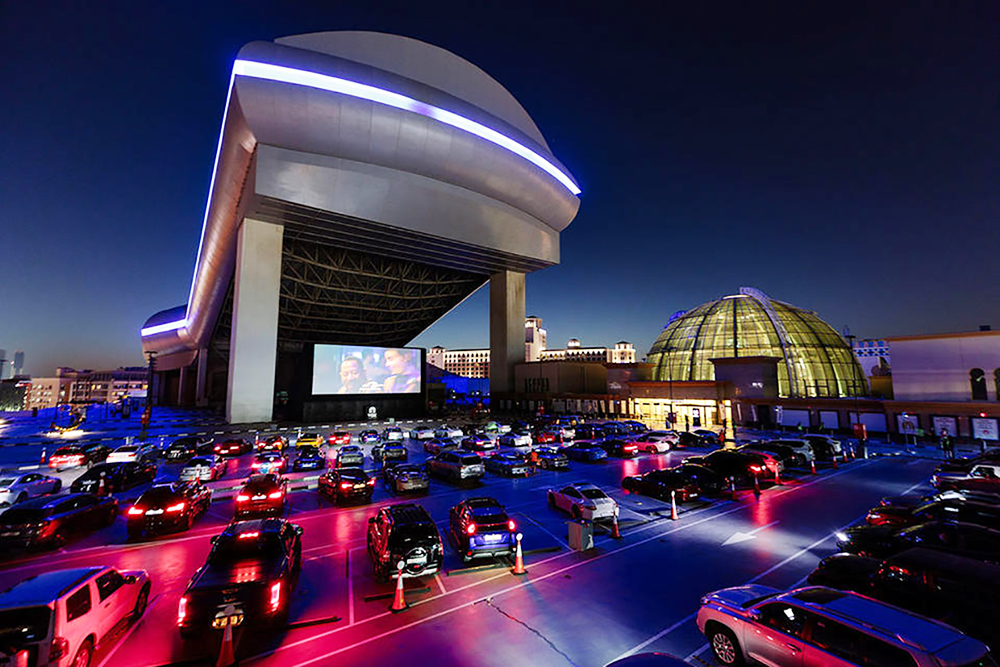
Patrons will then be directed to their designated parking slots and asked to turn off their headlights. Parking spaces are allocated based on the height of the vehicle in and effort to ensure that everyone can easily see the large screen.
The movie’s audio will be transmitted through a FM frequency directly to the In-Car Entertainment System, which will be indicated on the screen prior to the start of the pre-show and movie.
Within days of its official launch, the new VOX concept has been so well received, with all movie sessions sold out till early June. However, due to the extended lockdown in the UAE, which will take effect from 8pm to 6am starting Wednesday 20th May 2020, the drive-in cinema will remain closed till further notice.
Nevertheless, given its demand, the concept won’t be going anywhere, and you can expect it to generate as much popularity once it resumes operation.
Check out media kit and contact a member of our UAE sales team for more information on cinema advertising at the VOX drive-in cinema.
Sources: What’s On Dubai, Gulf News, Variety, The National and Arabian Business
A feature by Kaleem Aftab as published in BBC (Culture).
Theatres are closing around the world. Jobs are being culled. No one knows when projectors will be fired up again. Cinema is far from unique in being an industry under threat in the time of COVID-19. But there is a particular irony in the fact that many of us have turned to streaming platforms to deliver entertainment to fill the long hours of isolation, often watching content originally made for the silver screen. Audiences have increasingly been consuming more films at home anyway, of course. But now that trend has become a fact of life, many are questioning whether the culture of cinemagoing will resume in the same way once the pandemic abates.
The evidence from China doesn’t bode well. In recent years, China has posted huge box-office figures. In February 2019, Chinese audiences spent $1.63 billion on tickets, a record for a single month anywhere in the world. The contrast to February 2020 could not be greater.

A staff member sprays disinfectant at a Shenyang cinema on 25 March. Photograph Credits – AFP via Getty Images
Chinese theatres shuttered when the virus hit. In mid-March, an attempt to tentatively start opening cinemas again after the easing of the lockdown saw distributors refuse to release new films and audiences stay at home. Already, the almost 500 cinemas that tried to open have shut down again after receiving a letter from the government. Cinema-goers argued that it was too soon to open auditoriums and it was safer to watch films at home, especially when no vaccine for Covid-19 exists.
The situation is bad all over. In the UK, the popular Tyneside Cinema has started a donation campaign to ensure that it will be able to open its doors again. In New York, the world-famous Lincoln Center, home to the New York Film Festival, is one of many to serve redundancy notices as it faces a financial battle to keep going.
Compounding the misery for cinema owners is the fact that film studios have responded by putting films only very recently released in cinemas online. Last week, Disney made Pixar animation Onward available to rent on video-on-demand services, just over a month after its US premiere, while Universal have similarly uploaded The Invisible Man and The Hunt. And the same thing is happening with key indie films too: recent Berlin Film Festival award-winner Never Rarely Sometimes Always has also made the leap to streaming just a couple of weeks after its US opening. The consequence of all this is that studios may wonder why they’re sharing revenue with exhibitors if they can get a bigger cut by going straight to homes.
Indeed, while cinemas are on their knees, streaming platforms are profiting. Demand for home entertainment is so high that services such as Netflix and Disney + have announced they will reduce their picture quality in order to cut the data going to our homes by 25% so that the internet doesn’t get bottlenecked, slowing download speeds to a standstill.
But before we start imagining the liquidation signs going up at our local picture houses, it’s important to remember and celebrate how cinema has weathered societal storms throughout its history. Proclamations on the demise of the cinema have been a regular occurrence through the decades. And yet in 2019, the global box-office revenues from cinema were higher than ever.
How cinemas dealt with a past pandemic
A century ago, there was even the worry, as there is now, that cinemas would be permanently shut down by a virus. From 1918 to 1920, the so-called ‘Spanish Flu’ took the lives of 50 million people worldwide, coming right at the end of World War One, where 40 million died. When the flu hit, cinemas closed around the globe, although not quite in the same blanket way that they have today, with the decision on whether to close or not made by municipal governments in most countries.
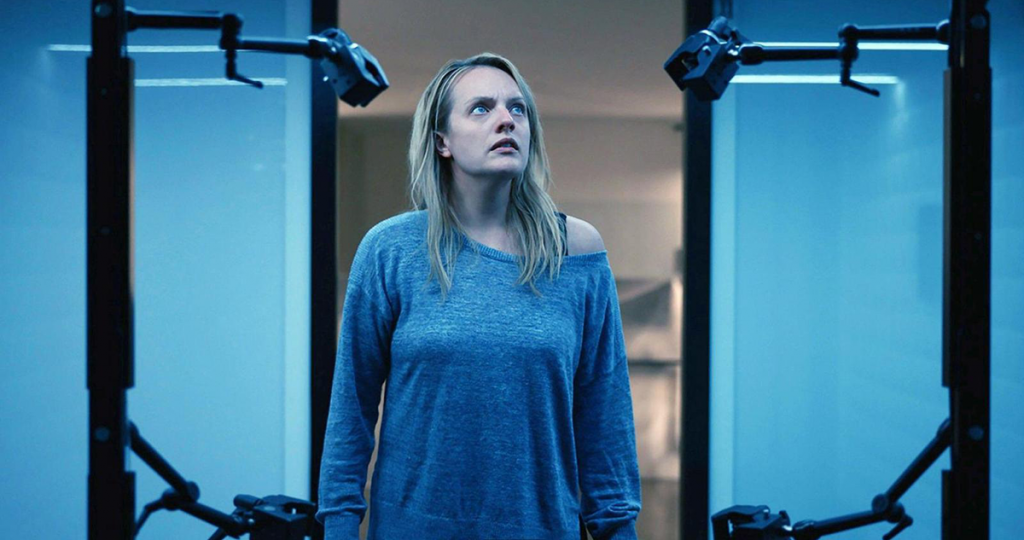
The Invisible Man (Image Credits – Universal Pictures)
Orders to close cinemas didn’t come lightly and proved controversial in places like the United Kingdom. Indeed as film historian Lawrence Napper notes, during World War One “for most of the time, they were open and very popular”.
The British government saw cinema as an essential tool for public well-being. “Cinema was the major leisure activity – it kept people occupied, and it helped keep them calm. It also kept them out of the pubs!” says Napper. “Drunkenness was a major issue for the authorities. But also cinemas became a key site for propaganda and a key point of contact between the individual, the local community and the national war effort.”
There was no single moment during the flu outbreak when all the cinemas in the UK shut, and some jurisdictions simply imposed mitigating measures. In London, cinemas were required to be ventilated for 30 minutes every three hours. Those in Wolverhampton banned children and removed carpets. A Walsall cinema showed a 15-minute public information film that featured a Dr Wise and a foolish patient. The advantage of this piecemeal localised policy-making for the industry was that, with films struck onto celluloid prints, and canisters moving from cinema to cinema, movies could shift around to areas that did not have restrictions in place.

Mirroring some of the debates being had today, about balancing the economic impact against the cost of lives, some cinemas owners complained about closing, Napper explains. “There are a lot of letters to the trade press from cinema managers saying the closing of cinemas because of the flu is nonsense, [and asking] ‘What about sporting events and factories? Why should it be cinemas that take the financial hit?’”
Cinemas were encouraged to open around Armistice Day, however, and a week of packed cinemas and celebrations followed – apart from in Edinburgh where influenza restrictions were kept in force. The film journal Kineweekly reported from the city that “there was a feeling that it was the hardest of hard luck that what should have been a record week was one of several which will rank as one of the most disastrous in the history of every house.”
Likewise, in the US, the closing of cinemas because of the flu happened on a regional basis. Critically, the home of the studios, Los Angeles, was severely affected and cinemas in California closed for seven weeks. Production companies withheld new releases and Hollywood studios stopped making movies in this period.
However, it should give us cheer to note that while the film industry in America was certainly impacted, it did not suffer overall but rather changed shape – and in fact flourished even further. As the film writer Richard Brody recently noted in an article for the New Yorker drawing parallels between now and then: “Many smaller companies went out of business, and the resulting shakeout led to a consolidation that made the big ones bigger, creating the studios that became the masters of production, distribution, and exhibition together; the flu, combined with the end of the war, gave rise to the mega-Hollywood that’s being duplicated again today.”
And with this organisational change, audiences only increased – in fact, attendances in the 1930s were higher than in any decade before or since. After The Great Depression of 1929, movies played a critical role in keeping people entertained. It was one of the few affordable means of escape. By numbers of attendees, 1939’s Gone With the Wind remains the most successful cinema release of all time.
World War Two was also, against the odds, a time in which cinema prospered. Many countries, including Britain, saw the cinema as a propaganda tool: a place to give information and boost morale, despite the obvious perils of congregating in public spaces. British cinemas closed for a week at the start of the war before reopening to much fanfare. “Cinema was a site for community activity [and] raising money for charity, [as well as a way for those abroad] to make contact with those at home,” says Napper.
The threat of television
The caveat to looking back at how cinema weathered turbulent historical times is that this all happened before television became ubiquitous. From the 1950s, cinemas didn’t have a monopoly on audio-visual entertainment. Governments also could now channel news directly into people’s homes, so cinema became less important as a propaganda tool. (The current epidemic has seen such dissemination of public information taken a step further with text messages sent straight to mobile phones.)
Television was the new game in town – it was also free to watch after the initial outlay, and creatives and producers suddenly became enamoured by the small box.
In Britain and the US, cinema admission figures have never been higher than in the year 1946, but after that, audience numbers dropped off steeply year by year. Both the McCarthy witch hunt of the early 1950s outing so-called communist sympathisers making movies, and the end of the Hays Code controlling sex and violence, meant that the cinema was suddenly perceived as a less wholesome, more morally tainted space, while television was deemed a safer experience. Meanwhile those in the industry themselves started lamenting the death of cinema as an artform. Legendary producer David O Selznick argued in 1951 that “Hollywood’s like Egypt, full of crumbled pyramids. It’ll never come back.”
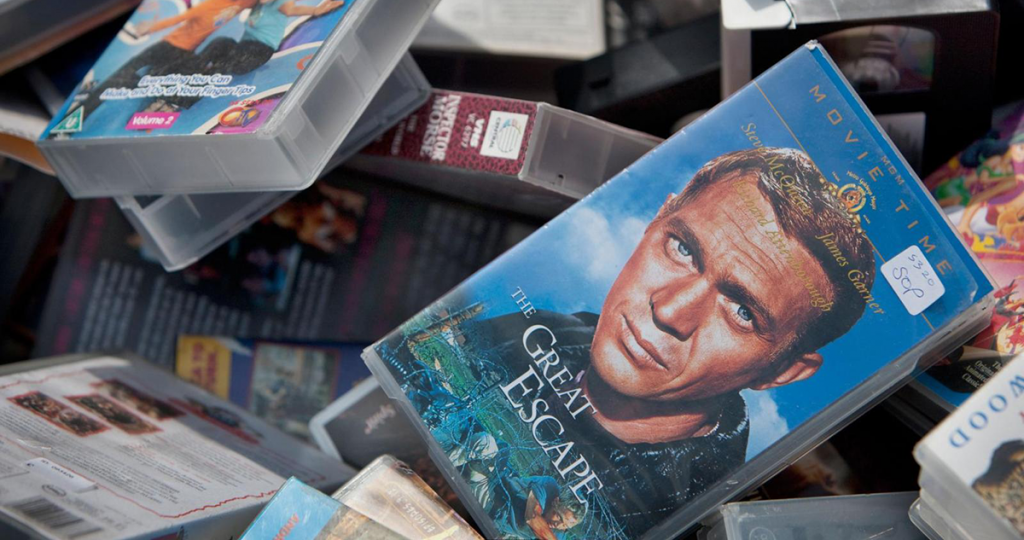
The invention of VHS tapes was seen as a danger to cinemas, but in fact it only served to enhance the value of the big-screen experience – Image by Alamy
But cinema was far from down and out. Rather, it was revitalised in the 1970s with the arrival of the summer blockbuster: the very thing that to some represented the ultimate desecration of cinema as an artform, but which reversed the decline in audience numbers. From Steven Spielberg’s Jaws (1975) onwards, blanket releases with mass-marketing became increasingly prevalent.
Then in the 1980s came another even more direct challenge to auditoriums. If television had wounded the size of audiences, it was thought that videotapes might steal them away completely. Invented in 1976, the VHS cassette tape (which quickly usurped its Betamax rival) made films available to own at home, or as more commonly occurred, to rent from video stores. No longer was the cinema the only game in town for cinephiles.

In fact, though, this rival medium served only to enhance the value of the cinema experience. Even though Quentin Tarantino has called the 1980s the worst era in American movies, national box-office returns almost doubled in that decade. Rather than being the death of cinema, video meant film studios had a whole new revenue stream to capitalise on, while home ownership only increased consumers’ passion for film, therefore making them hungrier to see new films from their favourite directors on the big screen. Cinema owners in turn came up with the cleaner and more modern ‘multiplex venues’. The industry rallied.
But if history would show that the cinema slayed the video, as one foe vanished, a new monster emerged for it to do battle with – streaming platforms. In the last few years, the likes of Netflix and Amazon have struck a double blow because at the same time as these companies have offered access to more and more films from the sofa, the original small-screen content they have served up has become ever better and more expensively produced. In 2015, Dustin Hoffman, one of the most celebrated movie stars of all-time, said “I think right now television is the best that it’s ever been and I think that it’s the worst that film has ever been – in the 50 years that I’ve been doing it, it’s the worst.”
Then, adding further peril for movie theatres, Netflix has increasingly lured in big-name directors like Martin Scorsese and Noah Baumbach to make feature-length work for them – but refused to play by the old rules and respect the so-called ‘theatrical window’, which gave cinemas exclusive screening rights to a film for a period of months before its home release.

Pre-pandemic, there were already signs that the culture of cinemagoing was starting to crack under this pressure. In 2018, the average price of an admission ticket in the United Kingdom went down for the first time in decades. The price fell again in 2019. And while overall box-office figures climbed, a smaller pool of films, mostly involving comic-book superheroes, were making the tills ring, and fewer studios were making all the money. Disney made over $11 billion in 2019, but small distributors have been struggling to survive, not helped by the fact that the bigger studios have started to open up their own streaming platforms, monopolising the ancillary market as well.
The new normal
However in the new Coronavirus-afflicted world, the battle with streaming platforms seems like relatively small fry. Since the coronavirus has spread across the world over the last couple of months, cinemas have closed, not in the patchy, ad-hoc fashion of 1918, but all at once.
Productions around the world have stopped shooting. Film Festivals have announced postponements and cancellations. The Fast and the Furious, sprinted to a 2021 release date, while the new James Bond film No Time To Die has been pushed back to November, and Black Widow has been delayed indefinitely. The livelihoods of millions around the globe have been threatened, by a collapse, not just of cinema, but of the industry itself. If cinemas are only closed for seven weeks as they were in Los Angeles in 1918, it would seem like a miracle. Some may never open again. Are we living out the text at the end of Jean-Luc Godard’s Weekend (1968): the fin… du cinema?
The level of the crisis and uncertainty facing the whole industry means it is difficult to contemplate the future at this moment in time, says Adeline Fontan Tessaur, the co-founder of French sales agent Elle Driver. “How can we anticipate anything and make definitive declarations? It’s way too early. We are trying right now to protect our industries. Everyone in the field is trying to anticipate the future and its damages. Of course, whether it’s productions, festivals, sales, or distributors, everything is on hold until we get more news. What happens is beyond one specific industry. We will have to adapt like everyone to this new world. Step by step.”

The effect of the virus has already been to make things that seemed unimaginable a month ago a reality. Hollywood studios have joined Netflix in breaking the theatrical window. Cannes has been postponed. Film festivals such as CPH:DOX and Visions du Reel are going online, with audiences watching premieres in the comfort of their own home. Arguments about the primacy of cinema have been rendered meaningless by the necessity to simply keep people watching.
And given that blockbusters rely on huge marketing campaigns, it’s unlikely that studios will want to take an immediate risk with their bigger titles when cinemas do eventually re-open – before they are sure if audiences are ready to embrace cinema again.
“There’s no doubt [the virus] is a huge challenge that affects all elements of the industry from development and production through to distribution and exhibition,” says Curzon CEO Philip Knatchbull, who runs a chain of cinemas in the UK as well as overseeing the Artificial Eye distribution label. “The immediate problem of course is weathering the financial impact of the loss of box office. When cinemas reopen there will be all sorts of challenges right along the supply chain, some of which won’t be immediately obvious right now.”
Why we shouldn’t despair
Cinemas are in a fight for their lives. The consequences of the current situation could be a wholesale shift in attitudes to streaming platforms and theatrical windows. Curzon had already moved to a day-and-date, simultaneous cinema and on-demand release model before the outbreak. “The theatrical v streaming debate has been very heated in recent years,” says Knatchbull. “There has been lots of speculation recently about how lockdown will impact on viewing habits. I don’t think that’s especially useful; this is a completely unprecedented and, hopefully, unique situation. That said, now is probably not the time for this discussion. Exhibitors and distributors need to work together creatively to see us through this period.”
But for all the sense of impending doom, history suggests that cinema will adapt and bounce back. Crowds flocked to the cinema after the 1918 pandemic, and videos only made people more interested in cinema, not less. After several weeks or, more likely, months cooped up indoors, watching films on our television sets and computer, the experience of seeing a film in cinemas the way they were meant to be seen will be all the more magical. It’s impossible for a home screening to match the technical quality of a film projected in the cinema – and there is also the indefinable adrenaline rush that comes from viewing a film in a large group, with audiences feeding off each other to create an intoxicating atmosphere as Bond gives chase, Daniel Blake starts protesting or Marcello Mastroianni raises an eyebrow. By the same token, most directors would continue to affirm that they first and foremost want their films seen in a cinema because it’s a unique experience.
Other reasons to be cheerful include the fact the overall global box office has only been rising recently, while the record-breaking box office of Oscar-winner Parasite in western countries shows how cinema has also been becoming a truly more globalised enterprise. What’s more, when it comes to movie theatres themselves, they have been getting more luxurious yet again of late, in a progression akin to the advent of the multiplexes.
Knatchbull agrees that cinema will find a way, as it has done throughout history, to thrive again. “Of course! Cinema has survived wars, pandemics and a host of technological changes. There is something elemental about gathering together in a dark room to watch a great film. I’m sure the reopening of cinemas will be a cause for a huge celebration and we’ll see audiences, desperate to get out of the house, flocking back to watch films on the big screen together.”
Source – BBC Culture (Why cinemas will bounce back from the Coronavirus crisis)
A feature on cinema post-pandemic by Jim Amos, as published on Celluloid Junkie.
It hasn’t been a pleasant two months for the movie industry, as moviegoing has been completely upended, along with the rest of the entertainment sector, by the coronavirus. With rare exception: Tenet, Mulan, Wonder Woman 1984, to name a few, most summer tentpoles have shifted to later in 2020 or early 2021 and there is lingering doubt in what numbers moviegoers will return to cinemas when we start to get the “all clear” sign by governments from around the world.
But here’s the good news. We are starting to see faint signs of hope on the horizon. The fact that studios are keeping their July and August releases on the schedule shows that they believe that moviegoing should be in a relatively fortuitous place by mid-late summer. Many ‘pundits’ who follow the film business are highly skeptical that films such as Tenet or Mulan will make their summer release dates but when you think about it there’s actually good reason for that glimmer of hope.
First, we have a population that has been sequestered in their homes and, gulp, hanging out with their families, for weeks now and are undoubtedly dying to get out to do something. Anything. People may not be ready to congregate with 80,000 of their closest friends at college football games or at stadium rock concerts but they may be more willing to head to movie theaters with 80-100 other people, especially if in-cinema social distancing measures remain in place or there is the available option to attend matinee shows which theoretically should have fewer patrons in attendance.
There is also the issue of ticket prices. Fans of concerts and live theater are undoubtedly going to be leery of dropping $100-200 for an upcoming show if there’s a chance that the virus returns in the fall or winter, as some predict, and events are once again canceled or postponed. It’s one thing to spend $10 for a movie ticket. It’s quite another to plunk down a rent payment for tickets to a concert that may not happen and if today’s cancelation clarification from Ticketmaster is any indication, concertgoers shouldn’t be looking to the ticketing giant for any kind of financial consideration.

‘Meet me at the multiplex.’ “WW84” – “Wonder Woman 1984” (Image Credits – WB)
The other thing to keep in mind is that a large percentage of people who buy tickets to shows and sporting events end up buying them ticket resale outlets at greatly inflated prices. Good luck getting your money back on those.
So yes, the movie industry as a whole, and the cinema industry specifically, are in very difficult straits. Some cinemas – large and small, are debating whether they’ll have the available cash to reopen. Those who do, however, might very well find themselves on the front line as the population starts to “toe dip” into the world of OOHE, or out of home entertainment. And studios are in a unique position where they can pivot quickly and actually move their release schedules forward if patrons start returning to cinemas in greater numbers than expected. Sporting events, concerts, live shows and the like don’t have that flexibility.
In addition, the move of tentpoles back to later in the year should provide independent studios such as Lionsgate, Focus, STX, and others the opportunity to grab summer playtime — albeit somewhat muted playtime — that they might not have enjoyed previously if the rest of the industry takes more of a wait-and-see approach.
Yes, there is a chance that moviegoers return slowly to cinemas but content consumers who are tired of streaming, terrestrial TV and their relatives could be salivating for any new content and their best bet would be a return to movie theaters. That doesn’t just apply to feature films but also to event cinema productions which may provide fans the opportunity to see concerts, filmed performances or events such as The Met opera, which they have been shut out of while they shelter in place, and at a fraction of the price. For fans of the band, Coldplay on screen is better than no Coldplay at all.

Not streaming to a device near you. “Tenet” – Only in Cinemas. (Image Credits – WB)
As well, this might also be the perfect time for studios and cinemas to come together on variable pricing plans. Luring moviegoers back to theaters with two-for-one deals or different levels of pricing for different films could be a welcome tonic for movie fans who might still be hesitant to return to cinemas or have been hard hit financially by COVID-19 yet still need a “night out” that won’t break the bank. Try getting that by buying a ticket to an Ed Sheeran concert or an Arsenal match.
The cinema industry hasn’t been a pretty sight these past several weeks and though we’ve seen articles galore about the plight of cinema chains we seem to have lost sight of the impact that coronavirus has had on individual movie theater workers, those employees who give up their Friday and Saturday nights, all for a poverty-level USD $15 an hour (if they’re lucky). Even if there’s precious little to play, cinemas will want to get their theaters open as quickly as it is safe to do so for several reasons, not the least of which is to rehire their workers in some form or fashion.
The good news is there is a light at the end of the tunnel and the movie industry is in a unique position to hold the lantern. There are still difficult times ahead but at least there is a path of opportunity that most other entertainment sectors simply don’t have.
See you at the movies. Hopefully soon.
Source – Celluloid Junkie (When We Return To “Normal,” the First Stop May Be The Movie Theatre)
4DX had its best year yet at Global Box Office in 2019, with CJ 4DPLEX – the company behind multi-sensory 4DX cinema technology, announcing it had a record-breaking year, grossing more than £246 million ($320 million) for 4DX worldwide.
Marking a 12% increase from 2018’s record of $286 million, it was the best year yet for the groundbreaking format. The uptick is partly credited to booming revenues in the U.S., where 4DX Box Office increased by 73% from 2018, while European markets grew by 17% from the previous year.
The announcement was further proof that a rising tide lifts all boats, after the global box office hit a record high in 2019, surpassing $42.5 billion. Overseas revenues also soared to new heights, topping $30 billion for the first time.
The trend toward premium and immersive cinema formats is helping to fuel this growth.
4DX provides cinema audiences a variety of special effects in cinemas, such as vibrating chairs, blowing winds, fog, and splashing water, through the use of specially designed in-theater technology.
Listed below are the 7 highest movies that smashed 4DX Box Office Records in 2019:
Avengers: Endgame – $34.4M

Aladdin – $25.9M

The Lion King – $23.2M

Frozen 2 – $18.8M

Fast & Furious Presents: Hobbs & Shaw – $16.9M

Captain Marvel – $14.0M

Spider-Man: Far From Home – $13.2M
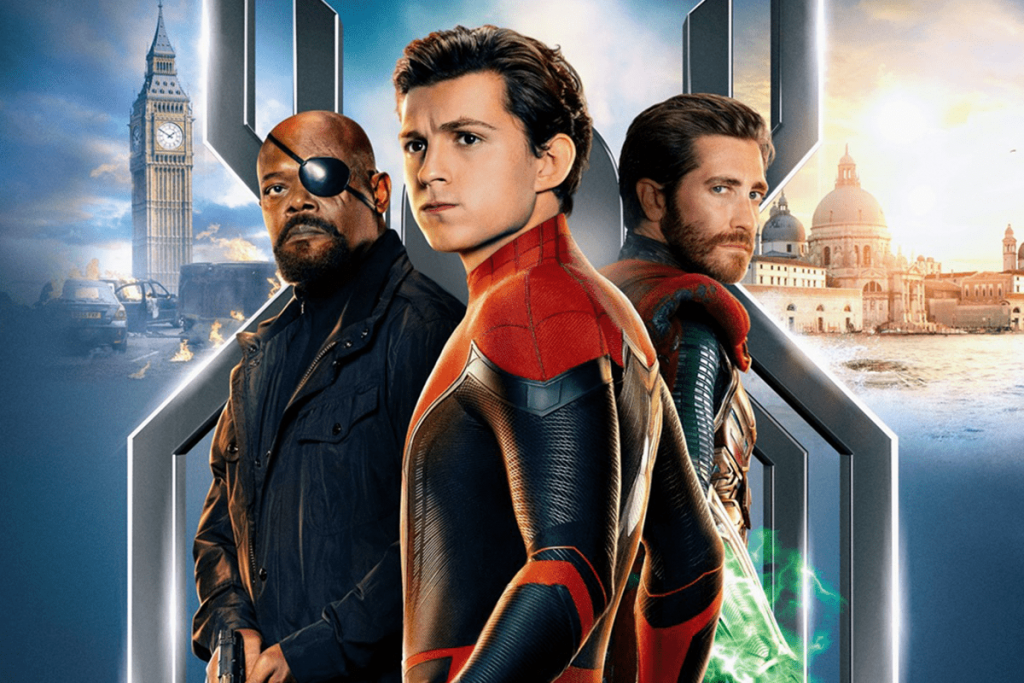
The top 4DX markets – Japan, China, Korea, France, U.S, Mexico and United Kingdom – together account for more than 66% of the format’s total global box office takings in 2019. These markets broke records in attendance and global box office, surpassing the top seven record of 2018. Most of all, U.S. became the biggest grosser among seven countries as 4DX box office grew more than 73% in comparison to 2018.
The multi-sensory format and Cinema Advertising
4DX engages audiences to be part of the adventure whilst experiencing the entirety of virtual reality, and also offers advertisers an exciting format of cinema advertising – guaranteed to create greater brand impact.
Here’s an article with example 4D cinema campaigns booked through MVM:
Achieve Greater Brand Impact with 4D Cinema Advertising
Break through the confines of advertising and explore the possibility of aligning your brand with a movies scheduled to release in 4DX format across the Middle East.
Mulan
No Time to Die
Black Widow
F9
Wonder Woman 1984
Top Gun: Maverick
Ghostbusters: Afterlife
Jungle Cruise
The King’s Man
Contact us for 4D cinema advertising opportunities across the Middle East.
Sources: Digital Cinema Report and PR News Wire
Commissioned by Motivate Val Morgan – market leader in cinema advertising across the Middle East, Ipsos – global market and opinion research specialist, recently conducted a study to evaluate the role of cinema advertising as part of the total cinema experience in Saudi Arabia.
The report, Cinemas in KSA – Audience Profile, Preferences and Perception of Advertising, examines the following:
The key objective of this study was to determine the value of adding cinema advertising to an advertiser’s media mix.
Click HERE to access report
AMC Cinemas has launched the first cinema loyalty program – AMC Da’era, along with a new and improved website and mobile app in Saudi Arabia.
AMC Da’era is a ‘first-of-its-kind’ rewards program designed exclusively for Saudi cinemagoers, allowing members to earn points for every riyal spend at AMC Cinemas. The loyalty program consists of three tiers: Inner, Select and Elite Circle, with each offering its own set perks and benefits ranging from birthday and anniversary gifts, F&B discounts, free refills and chances to win tickets to screenings and grand opening events.
Member of AMC Da’era will also receive a weekly newsletter with information on advance ticket bookings for blockbuster releases and new cinema openings across KSA.
The new and improved website amccinemas.com is a digital hub for movies (now showing and coming soon) and cinema schedules across all AMC locations. The website allows guests to narrow down their search by selecting a movie based on its title or showtime at a desired AMC location. The booking system allows guests to purchase tickets online and the website also comes with a ‘live chat’ feature to help solve guest problems.
The cinema app is designed will allow guests to finalize everything AMC has to offer in a seamless and speedy manner. Through the wide range of features available in both Arabic and English languages, booking a movie via the AMC app will become a fun ‘on-the-go’ process.
AMC Cinemas presently operates 11 screens across 2 locations (KAFD and Panorama) in Riyadh, and has plans to open 50 cinemas across Saudi Arabia over the next three to four years.
Click here for more information on AMC Da’era.
Sources: AMC Cinemas, Arab News and BraodcastPRO
Zain Saudi Arabia – mobile network operator in KSA, recently booked an integrated cinema campaign with Motivate Val Morgan – through OMD, for the launch of 5G technology in KSA.
The on-screen component included a 30 sec. ad which screened for a period of 4 weeks (12th December 2019 to 8th January 2020) at the following cinema locations:
The off- screen component included an advertisement (of the same content) on the LED screen at the entrance of VOX Cinemas – Riyadh Park from 12th December 2019 to 8th January 2020.
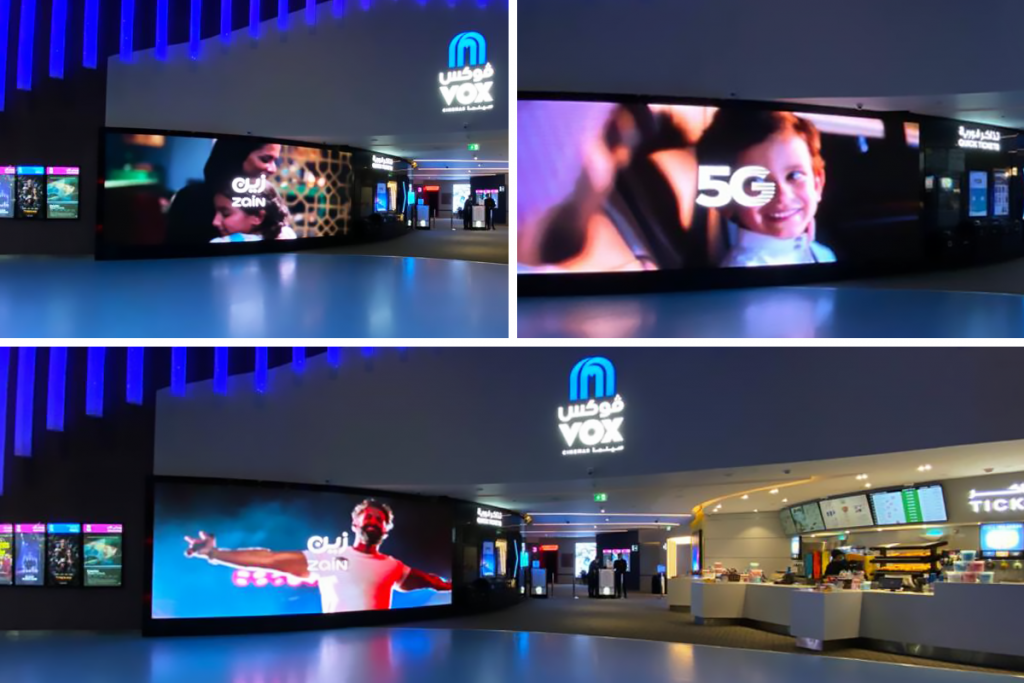
Integrated cinema campaigns provide greater brand visibility and enable brands to target cinemagoers across multiple touchpoints.
Contact us for more information on integrated cinema campaigns across our regional circuit.
Related Articles:
McVitie’s Digestive Nibbles | Integrated Cinema Campaign | KSA
Ülker O’lala Sufle | Integrated Cinema Campaign | KSA
Ministry of Commerce and Investment | Cinema Campaign | KSA
Chevrolet – American automotive manufacturer, booked a Car Display with Motivate Val Morgan – through Benchmark, at VOX Cinemas – Mall of Egypt.
The car display featured the all-new Chevrolet Malibu 2020, and was positioned in the foyer area of the cinema from 25th November 2019 – 1st December 2019.
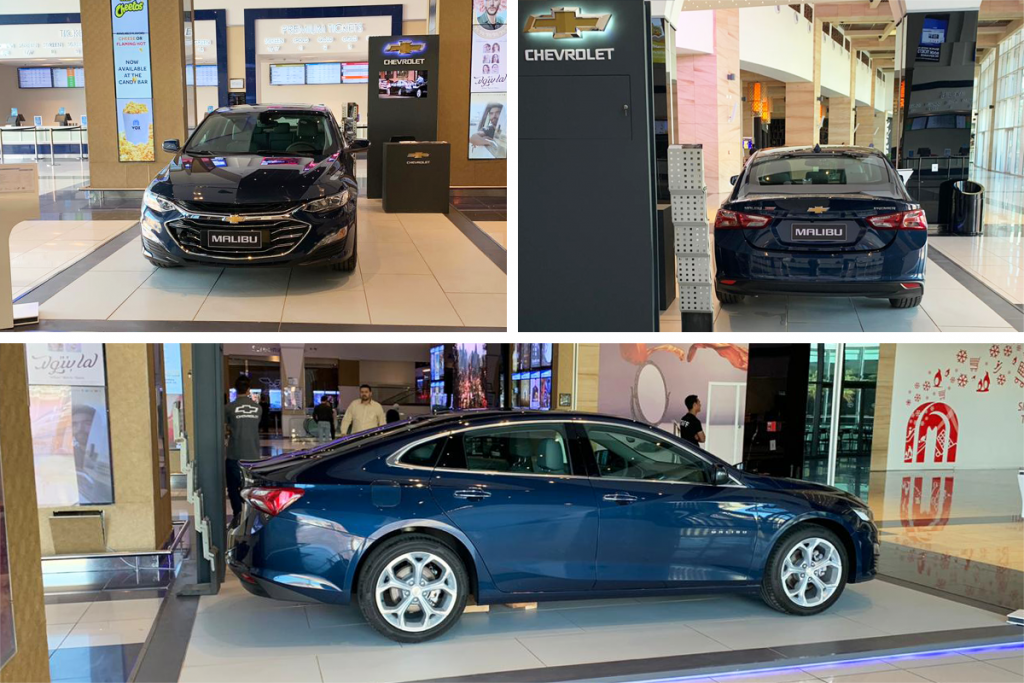
With a sophisticated, appearance and remarkable driving dynamics, the 2020 Malibu is ready to take you wherever the road leads.
Read more on the Chevrolet Malibu 2020 here.
Interested in booking a similar campaign? Contact us for more information on off screen opportunities across our cinema circuit.
Related Articles:
Peugeot | Cinema Campaign | VOX Cinemas | Mall of Egypt
Citroën Cinema Campaign – VOX Cinemas Mall of Egypt
Lexus | MIB: International | Partnership
McVitie’s – British snack food brand, recently booked an integrated cinema campaign with Motivate Val Morgan – through Arab Reach Media Services, for the launch of Digestive Nibbles Hobnobs in Saudi Arabia.
The on-screen component included a 20 sec. ad which screened for a period of 4 weeks (17th November to 14th December 2019) at VOX Cinemas – Red Sea Mall, Al Qasr Mall, and The Roof.
The off-screen campaign – which included a sampling activity, was executed at the above mentioned VOX locations. Phase 1 of the campaign ran from 21st to 23rd December 2019 and Phase 2 ran from 28th to 30th December 2019.



Promoters were hired by the brand to oversee the 6-day sampling activity at the respective cinemas and to assist with the distribution of Digestive Nibbles to cinemagoers walking out of the auditoriums at which the brand’s ad was screening.
A sampling activation is a great way to engage cinema audiences when launching a new product into the market.
Got a product launch in mind for your brand? Contact a member of our sales team to know more on how integrated campaigns can help move your brand closer to its target audience.
Related Articles:
Ülker O’lala Sufle | Integrated Cinema Campaign | KSA